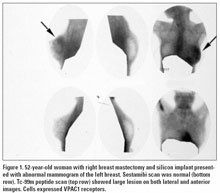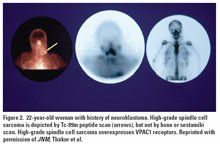Smart probes plus molecular biomarkers uncover cancer at the earliest signs
NEW ORLEANS-Molecular imaging is rapidly advancing as a biomedical modality that increases the understanding of underlying cellular mechanics and dynamics and adds a new dimension to the diagnosis and treatment of disease. It may be a sensitive and specific method for evaluating cancer by measuring the expression of genes that trigger oncogenesis and stratifying tumors on the basis of their biological characteristics
ABSTRACT: Gene profiles created for individual tumors could help tailor intensity of therapy and monitor its effectiveness. Matthew L. Thakur, PhD, discusses the profound influence genomic biomarkers will have on clinical practice.
NEW ORLEANS-Molecular imaging is rapidly advancing as a biomedical modality that increases the understanding of underlying cellular mechanics and dynamics and adds a new dimension to the diagnosis and treatment of disease. It may be a sensitive and specific method for evaluating cancer by measuring the expression of genes that trigger oncogenesis and stratifying tumors on the basis of their biological characteristics.
Future advancements in molecular imaging will allow physicians to detect malignancies before they even reach the millimeter or centimeter stage. MI could determine the gene profiles of individual tumors so the intensity of therapy would match the aggressiveness of gene upregulation. It could also monitor the effectiveness of therapy, not by looking at proxies of disease such as metabolism or standardized uptake value but by drilling down to the precursor of disease-the gene.

Central to these advancements is the development of biomarkers and targeted smart probes as well as the equipment to image them. In the Cassen Lecture at SNM 2008, Mathew L. Thakur, PhD, shared some of his thoughts about the profound influence that genomic biomarkers will have on molecular imaging and clinical practice in the future. Dr. Thakur is director of radiopharmaceutical and nuclear medicine research and a professor of radiology, radiation oncology, and nuclear medicine at Thomas Jefferson University in Philadelphia.
Describing genetic damage “Cancer remains a disease of the cell,” Dr. Thakur said. “Life begins as a single cell, which multiplies into an estimated 75 trillion cells. In order to sustain life, cells go through enormously complex chemical processes all their lives and all the time.
Researchers believe that modulation of the chemical network leading to damage of DNA transforms cellular chemistry into a chaotic process that creates many different biomolecules and pathways into the nucleus and the cytoplasm, he said. These molecules, which are both endogenous and exogenous, appear long before morphologic changes appear on imaging studies or pathologic changes appear on histology, the gold standard for the analysis of cancer.
“So it is a simple concept that if we target these molecules, we should be able to shed light on the pathways of cancer and develop biologic tools that may be used to create new ways of managing cancer,” Dr. Thakur explained. “Investigators in academia and industry are engaged in oncology research that will translate this knowledge into practical applications not only to detect cancer at an early stage but also to stratify it nonsurgically, treat it, and extend the quality of life of those affected by it.
Within the cancer research community, molecular biologists nevertheless need a better description of the genetic damage that drives human cancer. Managing the disease requires the understanding and interpretation of the complex network of proteins that are needed for cells to survive.
“We have made great progress in the treatment of tumors. We blast them with radiation and chemical agents and remove them with surgical excision, but we also hit normal cells along with the tumors. Future drugs, however, will target the molecular and genetic processes that initiate cancer. What will matter most in the future will be the molecular characteristics of cancer,” he said.
Finding occult cancers

One part of the emerging molecular imaging story involves the targeting of protein receptors, such as VPAC1, he said. In Dr. Thakur’s lab, studies are underway that use a technetium-99-mlabeled peptide that binds specifically and avidly to VPAC1. The lab also has turned its attention to is oncogenes, such as peptide nucleic acid (PNA) probes that may diagnose cancer with MRI, scintigraphy, or optical imaging technologies. One of these probes, positron-emitting copper-64, binds to oncogenes such as CCND1 in breast cancer cells and KRAS in pancreatic cancer.
“At present, if we want to confirm the presence of any malignancy, we have to take a biopsy into histology, and the pathologist distinguishes cells that are normal from those that are malignant. But morphology changes much later than the biochemistry of the cell. Since biochemical modulation occurs at the very beginning of the cancer development process, molecular imaging may be able to detect cancer without waiting until morphology changes have occurred and without having to take biopsy samples from tumors,” he said.
Determining susceptibility
Dr. Thakur and colleagues also are studying VPAC1 receptors in prostate cancer because detecting the disease at an early stage in men is as difficult as detecting early-stage breast cancer in women. Of 750,000 prostate biopsies done every year in the U.S., two-thirds are negative.

“We have been using the Cu-64 probe to study a group of transgenic mice. Th ese mice spontaneously grow prostate cancer by two to eight months of age and express VPAC1 receptors on the tumors. In one example, we found differences in two sibling mice. One had a large uptake of Cu-64; the other did not. We sacrificed the mice and could visibly see prostate cancer in the mouse that had exhibited intense Cu-64 uptake. Histologic analysis of the prostate tissue showed grade 4 hyperplasia.
Clinical literature indicates that 85% of men who have grade 4 hyperplasia develop prostate cancer within six months, and the remaining 15% develop cancer within nine months or a year. “If we can detect hyperplasia with a PNA probe, we will be able to detect prostate cancer before it can be found with current imaging techniques. We would avoid unnecessary biopsies and could begin to treat the patient six months early,” he said.
Imaging smallest, deepest structures
“If a microscope can see a single cell ex vivo, we should have equipment in imaging that sees small clusters of cancer cells in vivo,” Dr. Th akur pointed out.
To that end, researchers at Washington University in St. Louis, Stanford University in Stanford, Calif., and other sites are developing techniques that can image structures deep into the body with high resolution. One of these techniques uses nanotubes, which consist of carbon particles housed in a 1 or 2-micron tube, that can be bound to specific antibodies related to the receptors that are expressed by specific kinds of cancer. When the nanotubes are exposed to an electric pulse, they produce a signal that indicates there is a cancerous cell, he explained.
Dr. Thakur also described a pocket-size oncometer that could identify cancer cells that have not yet formed into clusters, but are still floating around in the body.
This test could determine if a patient is susceptible for having a cancerous gland in the future, Dr. Thakur said.
He discussed quantum dots, a new class of contrast agent for multimodal imaging. The fluorescent dots are nanocrystals of 1 to 10 nm in size that are capable of studying individual molecules within a single cell. Quantum dots are brighter than conventional contrast media, so only a small number of dots is needed to produce a signal. The dots are also stable, so images may be acquired over a long period without deterioration of image quality. They have a broad spectrum of excitation, so they can capture many biological signals, he added.
“Quantum dots one day may be used in a variety of ways to manage the cancer patient,” Dr. Thakur said, such as targeting specific cell-surface markers of cellular proliferation and firing up tumors to initiate apoptosis.